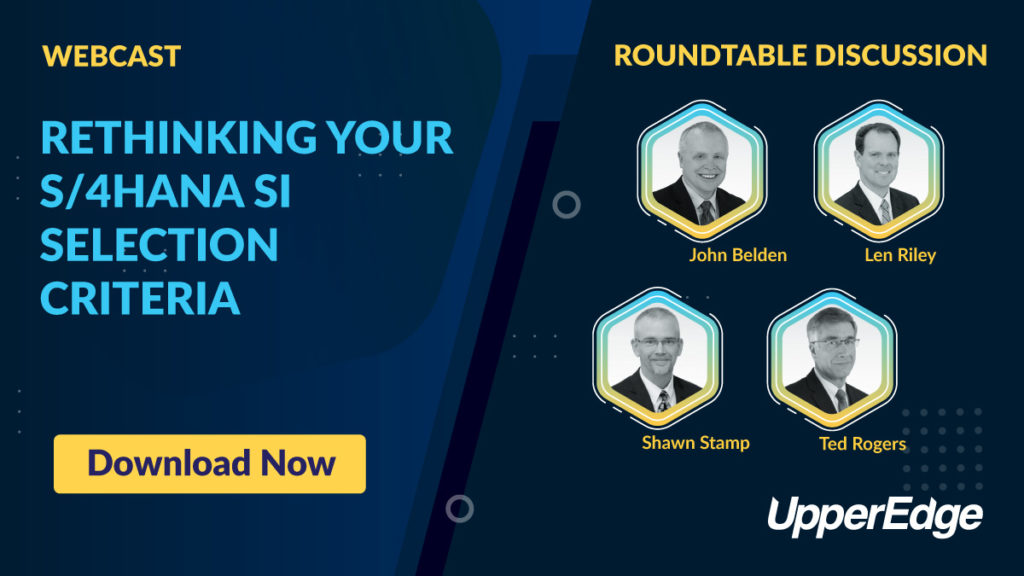- Ted Rogers
- Reading Time: 6 minutes

Much has changed over the last few years since the introduction of SAP S/4HANA, including conversion services, the introduction of SAP RISE, agile methods, and industry-based accelerators. In fact, given that most companies relaunch their transformation programs every 7-10 years, it is likely that the process has changed significantly since your last program.
This means that your company must review and adjust your RFP vendor selection criteria to better fit today’s market. In order to adjust them appropriately, there are details to include, exclude, change, or emphasize.
Specifically, understanding what your company needs as far as internal resources and understanding the emerging multi-vendor models are critical to a successful transformation program. Here, we will discuss what resources need to be prioritized within your company and what to keep in mind if you are considering a multi-vendor approach to your program.
Internal Resources Critical to the SI Selection Process
There are several issues that companies could be facing regarding their internal resources. Most importantly, every company right now is already lean, so you are likely trying to run a transformation with a leaner talent base.
We hear a lot about there being a fight for talent in the marketplace, but we now know that there is even a fight for talent within each company. Your company’s board of directors want to maximize the highest return to shareholders and are trying to figure out where they should put their key resources in order to do that. The following are three key considerations to take into account as you evaluate your internal resources ahead of your transformation program.
1. Top Tier Talent
Transformation programs are where you want your best people. Think of your company in two buckets: the first bucket houses your subject matter experts (SMEs), and the second bucket houses the people who are going to actually do the work. Once you have your SMEs identified, you need them to be involved during RFP development, RFP review, and SI orals.
One of the most critical steps in your transformation program is gathering those SMEs and the team that will see this project through. Some companies send in their most ready and available team during these phases, but what you really need is your top tier talent. It is important for companies not to delegate the RFP process and the SI selection process to their average and available team, but to the best and brightest your company has to offer.
When you see a staffing proposal coming in for your internal commitments, take the proposal and compare that to what the RACI looks like. Does the RACI support the staffing model for your participation and also support the staffing model for the roles and deliverables of the program? Ask yourself if you have the internal talent to support your responsibilities and if that is reflected in the RACI. Based on your answers to these questions, you can use the proposed RACI to advocate for additional or better fit resources that provide you both the capacity and capabilities expected to achieve what you are responsible to contribute, support or deliver.
2. RFP Proposal Estimations
The next consideration when there are two or three different SIs proposing is a variation of estimates. Sometimes the estimation for client participation can be as different as 50%. Those estimates are crucial because they tell you how well the SI understands your RFP. It tells you whether they’re perceiving the program as complex and, thus, will need your help, or if they are seeing it as a non-issue or a non-challenge that requires a lighter lift on their end. Look at those proposals and look for the gaps in your estimates, and then glean from those resources how each SI views your project.
The other things that you need to look for are the details that are not present in the proposal. If you’re seeing that these estimates are missing different resources for your team that you know should be there, that’s a key indication that there is a gap in your RFP that should be resolved immediately.
When planning the RFP process and the SI selection process, one of the things we recommend is to include exactly how the SMEs will be engaged pre-Statement of Work (SOW) execution and through the design process. Those are key, critical times for your SMEs to be participating, so it should be made clear how they fit into the overall program.
3. Missed Opportunities
When your best and brightest team doesn’t show up, or when your company is tight on resources, your SMEs are now trying to share their time between important issues in the company and their transformation projects. They do not have sufficient time to review proposals, review the scope, or review the estimates. They also don’t have the time to participate thoroughly in orals or in the review of the SOWs.
Unfortunately, we see this gap show up when you’re getting ready to sign that SOW. This causes a delay in the SOW execution and delays the entire program. The other time we see this gap show up is during the design phase or later in testing. In those cases, these gaps become a much more expensive issue. One of the areas we see gaps most often is in legacy demand. Here, we’re looking at how you’re going to connect to those edge systems and what resources are going to be there to help set that up and manage that environment.
Additionally, it is important to keep in mind that, while we want SMEs on board, we also want that next tier down for design sessions and testing as well as audit resources. You need that internal auditing built in throughout the process, not coming in at the end.
We are often asked which vendors have been able to provide these insights for their customers, and we have noticed that Accenture has no problem being brutally honest on what they demand of you. Some SIs underdeliver at the proposal phase because they know this is an issue internally, and they don’t want to come in with what may appear to be a bloated plan. Accenture usually provides the most reliable internal staffing plan.
Multi-Vendor Models
We are seeing a lot more multi-vendor models being proposed. With that, there are a few things your company should consider when it comes to these.
The first consideration is relevant to bolt-on software. There was a point in time where you would choose SAP and then you would buy and bring together everything with SAP. Now we’re seeing more bolt-on solutions, like Salesforce, ServiceNow, and even Workday. This, of course, presents some new challenges and new models to work with. Some SIs try to do this themselves and some SIs or customers will bring in a boutique vendor to put that particular bolt-on in for Salesforce, ServiceNow, or Workday. These multi-vendor models raise a couple of questions that you want to ensure you ask your SI.
1. SI Experience with Bolt-On Packages to S/4 Platform
First, regardless of who the SI is, you want to ask where they have done this particular bolt-on before and have them provide references that you can contact.
What you may find when you look at the resumes of the SI’s references is that the team that they’re proposing doesn’t have experience with your particular needs. They may have experience with SAP and they may also have experience with the bolt-on vendor you are interested in, but they do not have experience working in a program where you have SAP with that particular bolt-on together.
With so many moving parts in an engagement like this, it is critical that the proposed team have the appropriate experience and they know what they’re up against.
2. Increased Two-Tier Joint Proposals
We are also seeing a top tier and a second tier vendor partner together with a proposal for customers. The top tier provider will usually lead the design phase and play the role of a business integrator. The second tier provider will come in on the build and testing roles.
These types of proposals usually expose a couple of issues: First, the SI may not have the talent to do the full bandwidth of the program, and second, the provider may be trying to provide the customer a lower cost. They’ll give thought leadership at one price and then execution at another price.
There are some recommendations when working with two-tier proposals. First, you have to make sure that the partners have a shared scope and vision on how things are going to get done. We know the vendors won’t be sharing commercials, but they should be sharing the scope, the resource plan, the assumptions and, most importantly, the RACI. We also know there are still concerns about proprietary tools and assets. If these tools and assets are not shared as a result of one vendor not allowing the other vendor to use them, you’ll end up with lower productivity.
One of the requirements that we insist on in a two-tier joint proposal is the multi-party RACI by phase included in the RFP, discussed up through the orals, and memorialized in the SOW. Outline who is doing each task in design, who is doing each task in building, who is doing each task in testing, and who is doing each task in deployment.
One thing that often gets overlooked is the role of SAP Professional Services in your program. SAP’s Active Attention is usually advised, but are there other value-added services that SAP can bring to those solution architects? Sometimes, those are the keys to success, especially in the newer tools SAP is putting out on the market.
The Bottom Line
The market is likely not what it was when your company launched its last transformation program. One of the most important steps you can take as you prepare for your transformation program is to understand how the market has changed, evaluate your own company’s resources and potential shortcomings, and consider how you can make the most out of the SI selection process.

